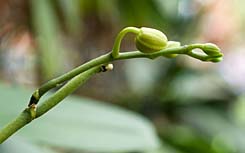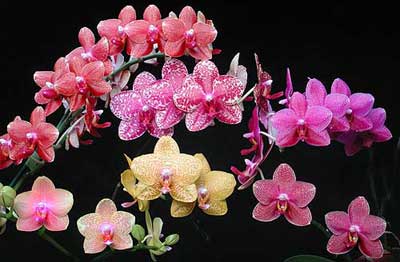
Phaleonopsis Orchid Care Instructions
Why won’t my orchid re-bloom?
Like all plants, orchids require sufficient light in order to produce flowers. Their care is actually similar to that of African Violets.
Leaf color indicates if the amount of light is adequate. The lush, rich, dark green of most houseplants is not desirable in orchid leaves. A grassy green color (light or medium green with yellowish tones) means the plant is receiving sufficient light to bloom.
Insufficient light is the most common cause of failure to re-bloom your orchid. Leaf color indicates if the amount of light is adequate. The lus, rich, dark green of most houseplants is not desirable in orchid leaves. A grassy green color (light or medium green with yellowish tones) means the plant is receiving sufficient light to bloom.
 Where do I cut the flower spike when it is finished?
Where do I cut the flower spike when it is finished?
Phalaenopsis will often introduce a secondary flush of flowersfrom a node on the existing stem. The tip of the flower spike will grow new flowers buds. But it can make the stem long and gangly looking.
When the flowers are finished, we suggest to cut the top 2 nodes ( bumps on the spike) which will encourage a new flower shoot to form. This process is easier and faster than cutting the flower spike and waiting for a new shoot to form.
Most of us ‘love’ our plants to death, by overwatering. Less is best with orchids! Constant wetness will cause the roots to rot, causing the leaves to droop, eventually killing the plant. The classic advice is to water the day before the plant dries out. Don’t be afraid to let the plant go dry, feel the weight of the plant to determine the weight of the dry plant. It will not kill the plant and will help you determine the water requirement.
If your home is very warm or has low humidity you will most likely need to water more often. Water your plant in the sink, run water for 15 seconds and drain. Do not let plants sit in water. Humidity trays” work well – trays or saucers of gravel or pebbles and a small a amount of water. The pot is placed on the pebbles above the water line. This increases humidity for the plant, and provides some air circulation under the pot.
Phalaenopsis (the moth orchid) will re-bloom from its old spike. Phalaenopsis will generally re-bloom given a little extra care. When the last flower fades, you can leave the spike (stem) on and it will still continue flowering. It is the easiest way for more flowers, but the spike becomes longer. Many Phalaenopsis stems will branch after the initial flower flush, especially if you remove the top two nodes (those little brown lines on the stem below where the flowers were) on the stem. One of these nodes will then initiate and generally produce flowers within eight to 12 weeks. Younger or weaker plants may not rebloom and some Phalaenopsis are genetically incapable of reblooming from the old spike. These are usually those that flower with branched spikes. It’s always worth a try. Orchids are susceptible to viruses, so whenever cutting an orchid plant always use a sterile tool to prevent the spread of virus. A straight edged razor blade is a good tool to use for cutting flower spikes.
 Fertilizing with Orchid Fertilizer
Fertilizing with Orchid Fertilizer
Orchids will do far better with too little fertilizer than with too much. Many growers recommend the “weakly, weekly” approach, applying a dilute (1/4 strength or less) fertilizer each time they water, rather than applying a full dose once a month. It is best not to fertilize a completely dry plant as the fertilizer can burn the dry roots. Water first then follow with fertilizer solution. In our West Coast climate conditions, with low light in the winter, do not fertilize from October to February.
Phal orchids like it warm – house temperatures of 19 – 30 degrees C.
However a few weeks at lower temperatures 13- 15 degrees C. will initiate new flower spikes to grow.
